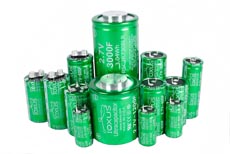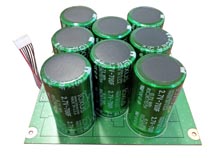Just when you think you're happy with the advancements in batteries, hold on to your electrons as ultracapacitors — or supercapacitors, depending on your phrase preference — make everything that came before them look ancient. Ultracapacitors are changing the way we think of energy storage. So forget about the days of just using capacitors as filters or coupling; try using ultracapacitors for energy storage — tons of it. And, by all means, forget that 1 farad was once considered a large value for a capacitor. Capacitors can now hold magnitudes above that.
The modern ultracapacitor has a very low equivalent series resistance (ESR) — in the 0.25 to 5.0-mΩ range — that translates into instant energy delivery with currents surpassing anything a battery can handle. As a result, ultracapacitors can deliver energy effortlessly and are perfect for our society, which demands instantaneous results in everything from mobile services to transportation. When combined with recent improvements in silicon, you can now get a standard chip that can charge an ultracapacitor from any source and to turn a capacitor decay curve into a constant, long-lasting power source that rivals that of batteries.
Excellent applications
Yes, you can easily turn a capacitor or a bank of capacitors into a battery-like system. However, unlike , where the charge time is usually long and sometimes cumbersome, ultracapacitors can be recharged with as much power as is available. Ultracapacitors are good at being cycled, which means they will not wear out quickly like a battery. In fact, ultracapacitors can undergo hundreds of thousands of cycles. Calculating an ultracapacitor's energy is simple — merely the 1/2CV*2 equation — so just measuring the voltage of an ultracapacitor provides all the information you need. And if you're wondering whether you can hook up several capacitors together, the answer is absolutely. When connecting multiple capacitors in series and/or parallel, you may need balancing circuits that run off the cell voltage.
Capacitors can be charged by solar panels, USB ports, cigarette lighter outlets in cars, and off the line. Once you understand how much power is available and for how long, you can put all of that power into the ultracapacitors by controlling the power to each device. As the cell is being charged, the current needs to be throttled back to match the available power you have. As an example, we know a USB 2.0 puts out 5 V at 500 mA from each port. There are chips on the market now that can convert that 2.5 W to a variable-current driver to charge up several ultracapacitors in a matter of seconds, while staying below that 500-mA threshold.
Discharge cycles within an ultracapacitor are just as simple. If you want to start a car, for example, simply connect up a bank of ultracapacitors to the starter and begin delivering hundreds, if not thousands, of peak amps. Conversely, if you are tired of buying alkaline batteries or waiting to find out if your rechargeables will function properly, just charge up a cell or two and connect them to a post regulator. Now you can turn that decaying voltage curve into constant power to run your light, drill, motor, or fan, or to do anything else that a battery can do.

Ioxus ultracapacitors come with values of 100 to 3,000 F.
Further advantages
Don't toss out all those ancient batteries just yet, though. A combination of batteries and ultracapacitors wired together makes for some great performance improvements. For example, a lead-acid battery cannot charge fast enough to deliver starting performance at every red light — a trait critical for the success of the start-stop systems common in cars today. However, if you put a bank of ultracapacitors in parallel with that battery, the combination can deliver the peak energy when it is needed any number of times, along with the power that is needed to run the car's accessories over a long time period. You no longer need to have huge, heavy lead-acid batteries just to handle the peaks; the ultracapacitors do that for you. The ultracapacitors allow for the use of much smaller and lighter lead-acid batteries, which results in even more fuel savings.
The ultracapacitor of today is an environmentally friendly product. You're not adding to landfills after just a few thousand cycles, as is the case with batteries. An ultracapacitor's end-of-life threat to the environment is minimal, since they are more than 95% recyclable and contain no heavy metals. They are truly built as cost-effective green energy solutions.

Ioxus iMOD modules hold multiple individually balanced cells to attain any voltage requirement.
The modern ultracapacitor has existed for years, with multiple manufactures competing for business across several applications — from transportation, to industrial and energy sectors. One example of a manufacturer optimizing the technology is Ioxus. Ioxus' lithium-ion hybrid ultracapacitors store more than twice the energy of a standard ultracapacitor. They weigh only a fifth of a comparable battery and are capable of more than one million cycles. Also available are iMOD modules that have multiple ultracpacitors and can meet nearly any voltage requirement.
Advertisement
Learn more about Ioxus





